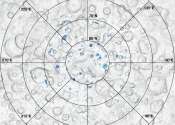Global coral bleaching caused by climate change demands a global response
The fourth global coral bleaching event, announced this week, is an urgent wake-up call to the world.

The fourth global coral bleaching event, announced this week, is an urgent wake-up call to the world.
Plants & Animals
Apr 17, 2024
0
7

Ceres, the largest asteroid in our solar system, harbors a dark secret: extremely young ice deposits in permanently shadowed craters near its poles. If that sounds vaguely familiar, it's because our moon and planet Mercury ...
Planetary Sciences
Apr 16, 2024
0
109

Frank Herbert's Dune is epic sci-fi storytelling with an environmental message at its heart. The novels and movies are set on the desert planet of Arrakis, which various characters dream of transforming into a greener world—much ...
Space Exploration
Mar 16, 2024
6
64

There are three levels of severity for space storms: geomagnetic storms, solar radiation storms and radio blackouts. These storms produce different effects on Earth, including satellite, GPS, communications and electrical ...
Planetary Sciences
Feb 27, 2024
0
106

The moon's newest arrival was said to be "alive and well" a day after making the first U.S. landing in half a century, but flight controllers were still trying to get a better handle on its bearings.
Space Exploration
Feb 23, 2024
2
24

Playing a huge role in moderating the climate, oceans are fundamental to the functioning of our planet. Understanding more about how seawater temperatures are rising and how oceans are absorbing excess atmospheric carbon ...
Earth Sciences
Feb 22, 2024
0
21

The reproduction of giant sea spiders in Antarctica has been largely unknown to researchers for more than 140 years, until now. University of Hawaiʻi at Mānoa scientists traveled to the remote continent and saw first-hand ...
Plants & Animals
Feb 19, 2024
1
45

The Arctic is experiencing disproportionately higher temperature increases compared to the rest of the planet, triggering a series of cascading effects. This rapid warming has profound implications for global climate patterns, ...
Earth Sciences
Feb 16, 2024
0
19

Communities of microorganisms at the bottom of polar lakes evolved independently from other regions, influenced by the particular geological, biological, and climate history of their regions. The unique character of the microbial ...
Evolution
Feb 14, 2024
0
19

Two new miniature NASA satellites will start crisscrossing Earth's atmosphere in a few months, detecting heat lost to space. Their observations from the planet's most bone-chilling regions will help predict how our ice, seas, ...
Planetary Sciences
Feb 12, 2024
1
9